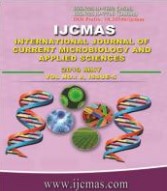


 National Academy of Agricultural Sciences (NAAS)
National Academy of Agricultural Sciences (NAAS)

|
PRINT ISSN : 2319-7692
Online ISSN : 2319-7706 Issues : 12 per year Publisher : Excellent Publishers Email : editorijcmas@gmail.com / submit@ijcmas.com Editor-in-chief: Dr.M.Prakash Index Copernicus ICV 2018: 95.39 NAAS RATING 2020: 5.38 |
The present study was carried out to find the integrated management of early blight of tomato (Lycopersicon esculentum Mill.) caused by Alternaria solani. Tomato (Lycopersicon esculentum Mill.) is an important vegetable crop which is grown all over the world. Early blight of tomato, caused by Alternaria solani is one of the most important diseases in tomato. Two fungicides i.e. Mancozeb 75 WP and Hexaconazole 5 EC at different concentrations (0.1%, 0.2% and 0.3%), two bio-agents viz., Trichoderma harzianum and T. koningii and two botanicals i.e. garlic bulb extract and neem leaves extract at different concentrations (5%, 10% and 15%) were evaluated in vitro against A. solani. On the basis of in vitro tests, both the fungicides caused significant inhibition of the mycelial growth. The highest inhibition of mycelial growth was recorded in all concentrations of Hexaconazole @ 0.1%, 0.2% and 0.3% with per cent inhibition of 94.44 followed by Mancozeb @ 0.2% with 93.33 per cent inhibition. In vitro screening of botanicals revealed that the per cent inhibition of mycelial growth was recorded most effective with 5% garlic bulb extract (84.81 %) followed by garlic @ 10% (79.63 %) and the least mycelial inhibition was exhibited by neem leaves extract@ 15% with 82.26%. Among the bioagents T. harzianum and T. koningii completely covered the mycelial growth of the test pathogen in 5 days and thus was highly antagonistic in nature and significantly reduced the growth of the pathogen. Under IDM, least mean value of disease severity was recorded from IDM2 (soil application of T. harzianum + seedling dip with garlic extract + foliar spray with Hexaconazole @ 0.1%) with 1.98 per cent. This was followed by IDM3 (burning with crop debris + seedling dip with Hexaconazole + foliar spray with garlic extract). Highest mean disease intensity of 23.04 per cent was recorded from IDM0 (control). Maximum growth and yield was recorded from IDM2 with 207.15 q/h with cost benefit ratio of 4.40.
 |
 |
 |
 |
 |